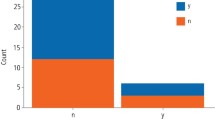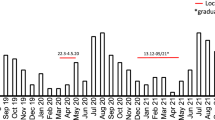Abstract
Introduction Electric scooters (e-scooters) are rife but are yet to be legalised in the UK. The aim of this paper was to investigate whether there had been an increase in the number of e-scooter injuries referred to the oral and maxillofacial surgery (OMFS) service at our unit. We present here what is, to our knowledge, the largest dataset regarding e-scooter-related injuries in the UK.
Method A double cohort study in which details of patients sustaining e-scooter-related injuries that were referred to the OMFS department were collected, prospectively, for a 16-week period in 2020 (investigation period). This was compared with data collected, retrospectively, from the emergency department (ED) referral database for the same date range in 2019 (control period).
Results In the investigation period, 12/649 referrals to OMFS from the ED were for e-scooter-related injuries. There were eight male patients and four female patients with a mean age of 35 years (interquartile range 24-48). Of these, only one patient was wearing a helmet and 8/12 had consumed alcohol. Head and neck injuries sustained included avulsed teeth, mandibular and midface fractures, skull fractures, facial lacerations and cervical spine injuries. One patient died as a result of their injuries. During the control period, 2/997 ED referrals to OMFS were for e-scooter-related injuries (12/649 versus 2/997; Fisher's exact test p <0.001).
Conclusion There was a significant rise in e-scooter-related injuries seen at our major trauma unit compared with 2019. We recommend that e-scooters are subject to at least the same requirements in safety equipment and sobriety as bicycles and that their top speed is limited to 12.5 mph. We hope that these measures will allow the benefits of this technology to be enjoyed while reducing associated morbidity and mortality.
Key points
-
Alerts the reader to evidence of an increasing frequency of dentofacial injuries related to electric scooters in the UK.
-
Alerts the reader to the relative severity of these injuries, in which more complex trauma may accompany dentoalveolar trauma. This is relevant for clinicians in primary care to consider if patients present there first.
-
Provides advice aimed at minimising injuries, which clinicians can consider for themselves, as well as informing their patients, in order to aid injury prevention/health promotion.
This is a preview of subscription content, access via your institution
Access options
Subscribe to this journal
Receive 24 print issues and online access
$259.00 per year
only $10.79 per issue
Buy this article
- Purchase on SpringerLink
- Instant access to full article PDF
Prices may be subject to local taxes which are calculated during checkout
Similar content being viewed by others
References
House of Commons Transport Committee. E-scooters: pavement nuisance or transport innovation? Third report of session 2019-21. 2020. Available at https://committees.parliament.uk/publications/2806/documents/27570/default/ (accessed March 2022).
Heathman A. Electric scooter sales are zooming ahead in the UK, while legislation trails behind. Evening Standard (London) 2020 February 18.
Barker M, Pepper T, Dua R, Fan K. Electric scooters: convenient transport or ED headache? Br J Oral Maxillofac Surg 2020; DOI: 10.1016/j.bjoms.2020.09.038.
Störmann P, Klug A, Nau C et al. Characteristics and Injury Patterns in Electric-Scooter Related Accidents - A Prospective Two-Centre Report from Germany. J Clin Med 2020; DOI: 10.3390/jcm9051569.
Moftakhar T, Wanzel M, Vojcsik A et al. Incidence and severity of electric scooter related injuries after introduction of an urban rental programme in Vienna: a retrospective multicentre study. Arch Orthop Trauma Surg 2021; 141: 1207-1213.
Puzio T J, Murphy P B, Gazzetta J et al. The electric scooter: A surging new mode of transportation that comes with risk to riders. Traffic Inj Prev 2020; 21: 175-178.
Farley K X, Aizpuru M, Wilson J M et al. Estimated Incidence of Electric Scooter Injuries in the US From 2014 to 2019. JAMA Netw Open 2020; DOI: 10.1001/jamanetworkopen.2020.14500.
Liew Y K, Wee C P J, Pek J H. New peril on our roads: a retrospective study of electric scooter-related injuries. Singapore Med J 2020; 61: 92-95.
Beck S, Barker L, Chan A, Stanbridge S. Emergency department impact following the introduction of an electric scooter sharing service. Emerg Med Australas 2020; 32: 409-415.
Brownson A B, Fagan P V, Dickson S, Civil I D. Electric scooter injuries at Auckland City Hospital. N Z Med J 2019; 132: 62-72.
Mitchell G, Tsao H, Randell T, Marks J, Mackay P. Impact of electric scooters to a tertiary emergency department: 8-week review after implementation of a scooter share scheme. Emerg Med Australas 2019; 31: 930-934.
Yarmohammadi A, Baxter S L, Ediriwickrema L S et al. Characterization of Facial Trauma Associated with Standing Electric Scooter Injuries. Ophthalmology 2020; 127: 988-990.
Dhillon N K, Juillard C, Barmparas G et al. Electric Scooter Injury in Southern California Trauma Centres. J Am Coll Surg 2020; 231: 133-138.
Alwani M, Jones A J, Sandelski M et al. Facing Facts: Facial Injuries from Stand-up Electric Scooters. Cureus 2020; DOI: 10.7759/cureus.6663.
Trivedi B, Kesterke M J, Bhattacharjee R, Weber W, Mynar K, Reddy L V. Craniofacial Injuries Seen With the Introduction of Bicycle-Share Electric Scooters in an Urban Setting. J Oral Maxillofac Surg 2019; 77: 2292-2297.
Blomberg S N F, Rosenkrantz O C M, Lippert F, Collatz Christensen H. Injury from electric scooters in Copenhagen: A retrospective cohort study. BMJ Open 2019; DOI: 10.1136/bmjopen-2019-033988.
Badeau A, Carman C, Newman M, Steenblik J, Carlson M, Madsen T. Emergency department visits for electric scooter-related injuries after introduction of an urban rental programme. Am J Emerg Med 2019; 37: 1531-1533.
Ishmael C R, Hsiue P P, Zoller S D et al. An Early Look at Operative Orthopaedic Injuries Associated with Electric Scooter Accidents: Bringing High-Energy Trauma to a Wider Audience. J Bone Joint Surg Am 2020; DOI: 10.2106/JBJS.19.00390.
Schlaff C D, Sack K D, Elliott R-J, Rosner M K. Early Experience with Electric Scooter Injuries Requiring Neurosurgical Evaluation in District of Columbia: A Case Series. World Neurosurg 2019; 132: 202-207.
UK Parliament. Written evidence submitted by Swifty Scooters. 2020. Available at https://committees.parliament.uk/writtenevidence/6155/html/ (accessed March 2022).
UK Parliament. PACTS' submission to the Transport Committee's e-scooters inquiry, June 2020. 2020. Available at https://committees.parliament.uk/writtenevidence/6086/html/ (accessed March 2022).
Author information
Authors and Affiliations
Contributions
Thomas Pepper conceived the study, conducted statistical analysis and drafted and revised the manuscript. Matthew Barker, Delia Smyth and Matthew Kingham collected data and drafted the manuscript. Radhika Dua conceived the study and drafted the manuscript. Kathleen Fan conceived the study, supervised the project and drafted and revised the manuscript.
Corresponding author
Ethics declarations
This study was registered as a service evaluation of treatment of facial trauma at King's College Hospital by the Oral and Maxillofacial Trauma Department during the COVID-19 lockdown period (DENT044-20). This was an observational study and did not require ethical approval according to the NHS Health Research Authority.
Rights and permissions
About this article
Cite this article
Pepper, T., Barker, M., Smyth, D. et al. Electric scooters: a quick way to get to the emergency department?. Br Dent J 232, 535–537 (2022). https://doi.org/10.1038/s41415-022-4153-6
Received:
Accepted:
Published:
Issue date:
DOI: https://doi.org/10.1038/s41415-022-4153-6
This article is cited by
-
Alcohol and electric scooter injuries in an emergency department: a prospective observational study
Scandinavian Journal of Trauma, Resuscitation and Emergency Medicine (2025)
-
Facial trauma due to e-scooters
British Dental Journal (2023)
-
Oral and maxillofacial injuries associated with e-scooter use at Broomfield Hospital: a cohort study of 24 months of data since e-scooter legalisation in the UK
British Dental Journal (2023)



